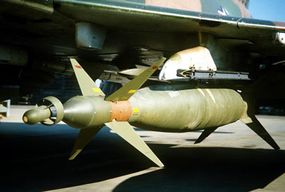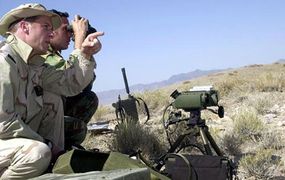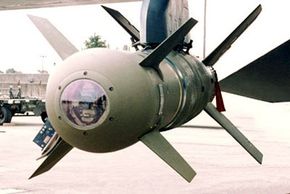Yesterday's Smart Bombs
Up until relatively recently, most smart bombs were either TV/IR-guided or laser-guided. Both types of bomb use visual sensors to locate ground targets.
A TV/IR-guided bomb has either a conventional television video camera or an infrared camera (for night vision) mounted to its nose. In remote-operation mode, the controller relays information through radio signals to a human operator, who is usually onboard the bomber plane. The remote operator relays commands to the control system to steer the bomb through the air -- the bomb acts something like a remote-control plane. In this mode, the operator may launch the bomb without a specific target and sight, and then pick up the target from the video as the bomb gets closer to the ground.
Advertisement
In automatic mode, the pilot locates a target through the bomb's video camera prior to launch and sends a signal to the bomb telling it to lock on to the target. The bomb's control system steers the bomb so that the indicated target image always stays near the center of the video display. In this way, the bomb zeros in on the locked target automatically.
Laser-guided smart bombs work a little differently. Instead of a video camera sensor, the bomb has a laser seeker -- an array of photo diodes. As you might expect, the photo diodes are sensitive to a particular frequency of laser light. For the bomb to see its target, a separate human operator, either on the ground or in the air, has to "paint" the designated target with a high-intensity laser beam. The laser beam reflects off the target, and the laser seeker picks it up.

The laser designator has its own unique pulse pattern. Before dropping the bomb, the bomber aircraft computer tells the missile's control system the specific pulse pattern (via an electronic "umbilical" connection to the bomb). Once the bomb is in the air, the control system is only interested in laser energy with this pulse pattern. The control system's basic goal is to steer the bomb so that the reflected laser beam is hitting near the center of the photo diode array. This keeps the bomb heading straight toward the target.

Both of these systems can be highly effective, but they have one major drawback: The bomb sensor has to maintain visual contact with the target. If cloud cover or obstacles get in the way, the bomb will most likely veer off course.
We'll explore today's smart bombs next.
